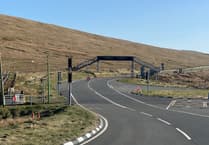Skylarks have been revealed as the bird most commonly struck by aircraft at Ronaldsway Airport.
A Freedom of Information (FoI) request submitted to the Department of Infrastructure shows that eight skylarks were struck by aircraft in 2024. There were also five meadow pipits killed along with one each of pigeon, house martin, stock dove, swallow, ringed plover, herring gull and brown hare.
There were 14 other creatures killed but were not recorded. Thankfully, in 2025 up to March there was only one unrecorded death.
There have also been a number of animals and birds culled to keep the airfield safe.
The DoI says: ‘Birds are only dispatched when they pose a threat to aircraft safety. When lethal control is required, birds are typically shot using a shotgun with rabbits and hares culled using a .25 calibre air rifle.
‘All culling is carried out humanely by trained and authorised personnel.
‘In some cases, animals are unintentionally killed following a collision or bird strike with an aircraft during landing or take-off.’
There were 88 rabbits culled in 2024 and nine up until March this year. The next most numerous animal to be culled is the herring gull with 64 last year and 22 up until March this year.
Pheasants, rooks and hares also reached double figures in the numbers culled.
There were also six black-headed gulls, six carrion crows, six hooded crows, five lesser black-backed gulls, four pigeons and two common gulls culled. One each of a blackbird, mallard duck, greater black-backed gull, greenshank and starling were culled in 2024.
Up until March 2025, as well as the rabbits and herring gulls mentioned, 11 pheasants and one each of a black-headed gull, greater black-backed gull, grey heron and a pigeon have been culled,
The DoI said: ‘If culled or found intact on the airfield, carcasses are hygienically sealed in plastic bags and sent for incineration.
‘If a carcass (or only partial remains after a strike) cannot be immediately identified, it is sent to a specialist laboratory in the UK for analysis/identification and safe disposal.
‘It is important to emphasise that non-lethal bird control methods are our primary and preferred approach.
‘These methods include auditory deterrents, visual deterrents (including specialist laser devices) and habitat management to make the airfield less attractive to birds and mammals.
‘Lethal control is only used as a last resort, when a significant and persistent threat to aviation safety has been identified and non-lethal measures have been ineffective.’
The DoI admits a small number of protected species have died on or around the airfield which it says is unavoidable.
The department says: ‘A small number of birds listed under Schedule 1 of the Wildlife Act 1990 appear in the statistics provided.
‘These include several skylarks involved in bird strike incidents during aircraft take-off or landing, as well as a single starling that was recorded as culled.
‘Starlings, although protected, are highly mobile, small, and fast-moving birds that often travel in dense, erratic flocks (known as murmurations). They are among the most commonly observed bird species on the aerodrome.
‘Personnel involved in wildlife control are specifically trained and authorised for the role, and deliberate targeting of Schedule 1 species is not permitted and does not occur.
‘The airport remains committed to ensuring that wildlife control is carried out with due regard for both aviation safety and environmental protection legislation.’
.jpeg?trim=0,0,0,0&width=752&height=501&crop=752:501)

.png?width=209&height=140&crop=209:145,smart&quality=75)

